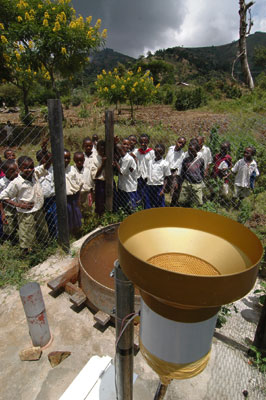TU Delft researchers are using gift cards to measure rainfall. Their odd sensors must eventually provide insights into hydrology in Africa and on the TU Delft campus.
From a small gift that, when unfolded, has Diana Ross singing the hit ‘A brand new day’ to celebrate your marriage, to a device registering the sound of rain drops. That’s the peculiar metamorphose that sound-emitting gift cards undergo when they fall into the hands of a few researchers at the department of water management.
PhD student Rolf Hut and graduate ir. Coen Degen, and MSc student Stijn de Jong, used the speaker from a gift card to make a sensor that measures rainfall by counting the droplets that fall on it. The sensor will be part of a bigger weather station the researchers are developing for hydrological research on the African continent.
Professor Nick van de Giesen, supervisor of the three researchers, wants to install 20,000 small weather stations across Sub Saharan Africa linked to a wireless network, each costing no more than 100 euro. The stations will measure wind speed, evaporation, radiation, rain fall and so on, while adding to the rough data that is now obtained by satellites.
Since the stations must be cheap, simple and robust, transforming electronic gadgets from consumer goods into useful instruments are the way to go. That’s the adage of these researchers who recently also used highly sensitive acceleration sensors from a Wii to make evaporation and wind speed instruments.It’s time for Diana Ross to stop singing now. Hut dismantles the card and shows the electronics inside. The speaker consists of a thin, piezoelectric disc that changes shape when exposed to electrical currents, thereby creating sound. “But it can just as well work the other way around”, says Hut. “When a droplet hits the piezoelectric material it causes vibrations and thus electrical signals.”
To demonstrate this principle, Hut opens the valve of a shower. Placed beneath the shower head is a piece of piezoelectric material from a card. The sound of rain on a tent, though sounding a bit more metallic, fills the room.
In the field, the sensor will of course not be linked to a stereo system like in this promotional set up, but to a logger that registers when it rains, for how long, how hard, and how big the droplets are. “The system must be able to tell all this by analyzing the sound”, De Jong explains.
Not only Africa will benefit from the sensor. As part of the ‘climate city campus’ project, which aims to measure climate in the urban environment and which will be launched by TU Delft this spring, De Jong will measure the rain fall around the high rise building of the faculty of Electrical Engineering, Mathematics and Computer Science.
“We don’t really know how wind and rain are affected by buildings in cities”, says De Jong, who plans to install hundred sensors on the roof of a building next to the high rise this summer. “We only talk about average rainfall in a city, but the differences from location to location can be huge.”
According to Van de Giesen, gaining insights into these differences and the dynamics of climates in cities is of great importance: “Many drainage systems are old and due for replacement. If we want to cope with climate change in cities we need to get a clearer picture of the rain fall. At some places you may need wider sewers than at others, for instance.”
De Jong has already started some fieldwork on the roof, but because of the snow he hasn’t been able to conduct any measurements. Still, he has indications that the rain fall differs greatly between a spot close to the high rise and a one a hundred meters further. “There are a lot more small plants growing here between the stones”, he points out. “That’s because here in the shelter a lot of dirt, sand and seeds fell from the sky.” Differences in wind speeds will certainly affect the rain as well, he believes.
De prijsvraag is nadrukkelijk bedoeld voor alle TU-studenten, niet alleen die van Industrieel Ontwerpen. De wedstrijd is tot stand gekomen door samenwerking tussen de gemeente, de universiteit en de stichtingen Het geschenk van Delft en Bluedot.
Bluedot bestaat inmiddels twee jaar en heeft als doel studenten te helpen bij het op de markt brengen van hun producten en ontwerpen. Sinds een jaar verkoopt de stichting onder meer via hun website zeven producten die door studenten zijn ontworpen. Het heeft een bestuur van studenten.
Rick Passenier is een van de bestuursleden. Hij vertelt dat de prijsuitreiking half juni gepland staat. Op 22 april wordt de ontwerpwedstrijd officieel geopend.
Maar nu al kunnen studenten nadenken over hun ontwerpen. Er zijn drie categorien: tot twee euro (bijvoorbeeld pennen en briefopeners), tot 25 euro (bijvoorbeeld servethouders) en tot 40 of 50 euro (bijvoorbeeld wijnkoelers). Er komt ook een speciale keramiekprijs, uitgereikt door de Porceleyne Fles.
De vraag is hoe creatief studenten kunnen zijn als ze onder de twee euro moeten blijven. Passenier denkt dat er nog genoeg mogelijk is. “Neem een pen. Die kan vast leuker, beter en innovatiever dan wat er tot nu toe mee is gedaan.”
Een vereiste is dat studenten een model van hun concept inleveren. Dat kan een fysiek model zijn, maar virtueel mag ook. Verder moeten studenten een kort presentatievel op A2-formaat maken.
Winnaars kunnen tot drieduizend euro prijzengeld verdienen. Verder wordt er een selectie gemaakt van producten die daadwerkelijk gemaakt worden.



Comments are closed.